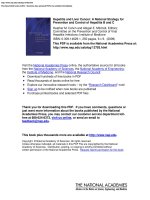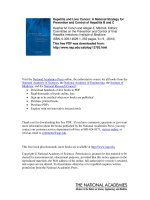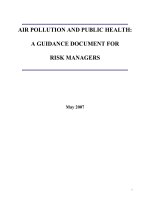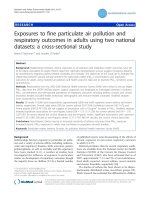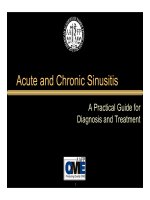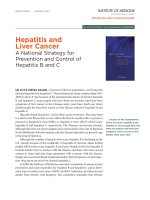Comparing early years and childhood experiences and outcomes in Scotland, England and three city-regions: A plausible explanation for Scottish ‘excess’ mortality?
Bạn đang xem bản rút gọn của tài liệu. Xem và tải ngay bản đầy đủ của tài liệu tại đây (311.19 KB, 10 trang )
Taulbut et al. BMC Pediatrics 2014, 14:259
/>
RESEARCH ARTICLE
Open Access
Comparing early years and childhood experiences
and outcomes in Scotland, England and three
city-regions: a plausible explanation for Scottish
‘excess’ mortality?
Martin Taulbut1*, David Walsh2 and John O’Dowd3,4
Abstract
Background: Negative early years and childhood experiences (EYCE), including socio-economic circumstances,
parental health and parenting style, are associated with poor health outcomes both in childhood and adulthood. It
has also been proposed that EYCE were historically worse in Scottish areas, especially Glasgow and the Clyde Valley,
compared to elsewhere in the UK and that this variation can provide a partial explanation for the excess of ill health
and mortality observed among those Scottish populations.
Methods: Multiple logistic regression analysis was applied to two large, representative, British birth cohorts (the
NCDS58 and the BCS70), to test the independent association of area of residence at ages 7 and 5 with risk of
behavioural problems, respiratory problems and reading/vocabulary problems at the same age. Cohort members
resident in Scotland were compared with those who were resident in England, while those resident in Glasgow
and the Clyde Valley were compared with those resident in Merseyside and Greater Manchester.
Results: After adjustment for a range of relevant variables, the risk of adverse childhood outcomes was found to be
either no different, or lower, in the Scottish areas. At a national level, the study reinforces the combined association
of socio-economic circumstances, parental health (especially maternal mental health) and parenting with child
health outcomes.
Conclusion: Based on these samples, the study does not support the hypothesis that EYCE were worse in Scotland
and Glasgow and the Clyde Valley. It seems, therefore (based on these data), less likely that the roots of the excess
mortality observed in the Scottish areas can be explained by these factors.
Keywords: Child health, Spatial analysis, Social and life-course epidemiology
Background
Early years’ and childhood experiences (EYCE), including
socio-economic circumstances, parental health and parenting style, play an important role in determining childhood
outcomes, especially social, emotional and mental health,
physical health and learning and development. Risk of
childhood behavioural problems is increased by factors
such as poverty, low educational attainment and housing
difficulties, smoking in pregnancy and maternal malaise,
as well as low perceived parenting skills [1-4]. Physical
* Correspondence:
1
NHS Health Scotland, Meridian Court, 5 Cadogan Street, Glasgow, Scotland
Full list of author information is available at the end of the article
health in childhood, including limiting long-term illness
and asthma, is associated with poor maternal physical
health and low household income [5,6]. Children’s cognitive skills (e.g. vocabulary, visual-motor coordination) are
also highly correlated with household income [7] as well
as maternal educational attainment, poor maternal health,
early motherhood and aspects of parenting [6].
EYCE and their associated outcomes can have consequences for health later in life [8]. Beginning with the
experiences themselves, analysis of British birth cohort
data has found that childhood material disadvantage
(such as paternal social class and living in social housing) increases the risk of poor self-reported health,
© 2014 Taulbut et al.; licensee BioMed Central Ltd. This is an Open Access article distributed under the terms of the Creative
Commons Attribution License ( which permits unrestricted use, distribution, and
reproduction in any medium, provided the original work is properly credited. The Creative Commons Public Domain
Dedication waiver ( applies to the data made available in this article,
unless otherwise stated.
Taulbut et al. BMC Pediatrics 2014, 14:259
/>
smoking and premature mortality in adulthood [9,10].
Other research has found that people reporting poor
relationships with their parents in childhood and adolescence are more likely to report three or more health
problems in adulthood and, in the case of women, have
poorer psychological well-being [11,12]. Exposure to
adverse child experiences (such as abuse or neglect),
problem behaviour in childhood and parental disinterest
in their child’s education when the child was aged 11, also
increases the relative risk of premature death [13,14].
Turning to the outcomes arising from EYCE, childhood
social, emotional and mental health (especially conduct
disorders) and psychological health disorders have also
been found to be associated directly with increased risk of
poor adult health, including smoking and worse mental
and physical health, in adulthood [15,16]. They are also
associated with adult determinants of poor health, such as
lower educational attainment, reduced economic participation and earnings, relationship difficulties, financial
problems and being in trouble with the law [16,17].
Poor childhood physical health appears to increase the
risk of poor self-reported general health, respiratory
problems and depression in early adulthood [18] and
chronic health conditions in older working-age adults
(aged 55–65) [19]. In addition to the direct association,
childhood morbidity is associated with lower educational
attainment and earnings in adulthood [20], which may
make a further contribution to adult ill-health.
Finally, childhood cognitive development is associated
both indirectly and indirectly with adult health. Lower
levels of cognitive development at age seven have been
shown to be associated with increased risk of chronic
illnesses in adulthood [21]. Higher levels of childhood
cognitive development can also lower the risk of poor
mental health in adulthood for women (although it may
also increase the risk of alcohol abuse for both genders)
[22]. Improved childhood learning and development
outcomes can also protect adult health indirectly through
their association with higher levels of educational attainment, and lower risk of both economic inactivity (for men
only) and receipt of welfare benefits in middle-age [23].
Negative early years’ and childhood experiences have
also been proposed as a possible influence on the ‘excess’
levels of poor health seen in Scotland, especially in
Glasgow and the West Central Scotland conurbation
[24]. This ‘excess’ relates to the higher levels of mortality
seen in Scottish areas, even after controlling for age, sex
and deprivation. It has been shown to exist for Scotland
compared with England [25] and more recently for
Glasgow compared with Liverpool and Manchester,
where despite these cities sharing identical deprivation
profiles, premature mortality is 30% higher in the Scottish
city [26]. Geography of residence (in Scotland compared
to England, and Glasgow and surrounds compared to
Page 2 of 10
similar English conurbations) therefore seems an important independent influence on rates of adult morbidity
and mortality, though the factors driving this difference
remain unclear.
Following publication of these studies, a number of
hypotheses were proposed, ranging from ‘upstream’ (e.g.
social and economic inequality, deindustrialisation) to
‘downstream’ explanations (e.g. differences in health behaviours or individual values) [27]. Early years and childhood
factors, especially family breakdown, acrimony between
partners or dysfunctional parenting, were included among
these hypotheses as a ‘midstream’ explanation. Although
these are hard to measure directly, we can measure childhood health and social outcomes associated with negative
early years and childhood factors, and include geography of
residence alongside wider determinants of health. If this
theory is plausible, it might be expected that living in
Scottish areas in childhood would also be associated
with increased risk of poor childhood outcomes, after
adjustment for a range of other relevant variables.
In 2013, the Glasgow Centre for Population Health
published a report comparing early years’ and childhood
experiences in Scotland, England and three ‘city-regions’
(Glasgow & the Clyde Valley (GCV), Greater Manchester
(GM) and Merseyside) [28]. Its purpose was to investigate
whether there were differences in these health determinants that might help explain the poor health of Scotland
and GCV relative to these areas. Few clear differences
in contemporary childhood and early years’ experiences
emerged from the analyses. The exceptions were smoking
during pregnancy and breastfeeding at a national level,
although at a regional level the size of these differences
diminished or even disappeared. There were also more
ambiguous findings on dysfunctional households, parental
warmth and shouting at children. However, the study
was descriptive only and did not test for the influence
of multiple factors simultaneously on childhood health
outcomes.
This paper fills a gap in the knowledge base by formally
testing whether historic early years’ and childhood experiences were worse in Scotland and GCV compared to other
places, all other things being equal. It does this by using
more sophisticated statistical methods –multiple logistic
regression analysis – to examine the association between
geography of residence and child health outcomes, while
controlling for a range of important social, economic and
family characteristics.
The hypothesis is that the early years’ experiences (in
particular child poverty, parenting, or some combination
of these) for children growing up in Scotland and West
Central Scotland was worse compared to children growing
up in England, Merseyside and Greater Manchester.
This led to poor childhood outcomes, which in turn fed
through to poorer adulthood health and higher rates of
Taulbut et al. BMC Pediatrics 2014, 14:259
/>
morbidity and premature mortality. In this phase of research the focus is on exploring whether or not residence
of Scottish areas in childhood resulted in poorer childhood health outcomes, even after taking other factors into
account.
Methods
Two large cohort studies, the National Child Development
Study (NCDS58) and the British Cohort Study 1970
(BCS70), were used to test the hypotheses. It was decided
not to use the Millennium Cohort Study (MCS), despite
its more comprehensive measures of parenting and health,
because its Merseyside sample largely excludes Liverpool
City residents and was therefore considered unrepresentative. Essential to this research, both the NCDS58
and BCS70 record cohort members’ area of residence
(at a national and sub-regional level) at each sweep
[29]. Informed consent was obtained from the parents of
cohort members for childhood measurements. NCDS58
and BCS70 data are open access datasets available to
non-profit research organisations.
Participants
Only cohort members resident in Scotland or England
were selected for the national analyses, providing 14,585
cases in the NCDS58 and 12,323 in the BCS70. For
regional comparisons, only cohort members living in
Glasgow & the Clyde Valley, Greater Manchester or
Merseyside at ages 7 (NCDS58) and 5 (BCS70) were
chosen, with a total of 1,502 NCDS58 cases and 1,247
BCS70 cases. Tables 1 and 2 provide descriptive statistics on the original datasets.
Measures
Outcome measures
Three outcome measures, measured at age 7 in the NCDS
and age 5 in the BCS70, were derived. These were behavioural problems, respiratory problems and reading/vocabulary problems. The measures were chosen because of their
association with negative early years’ experiences and with
subsequent risk of poor health and disadvantage in adulthood, as discussed above.
Behavioural problems were measured using Rutter scores
at ages 5 (NCDS58) and 7 (BCS70). To derive these scores,
cohort members’ mothers were asked a series of questions
describing behaviour shown by many children and asked
to what extent these applied to their own child (e.g. child
‘is miserable or tearful’, ‘is squirmy or fidgety’, ‘prefers to do
things on his/her own rather than with other children’
(never/sometimes/frequently)). Responses to these questions were then combined into an index used to detect
emotional/behavioural disturbances in children [30]. Using
an approach described elsewhere [31], cohort members
were classified as having normal (below the 80th
Page 3 of 10
percentile), moderate (80th-95th percentile) or severe
(above the 95th percentile) behavioural problems. This was
then dichotomised into a simple normal vs. moderatesevere category. Respiratory problems were defined as the
cohort member ever having an asthma attack or bronchitis with wheezing (NCDS58), following Strachan and
Butland [32], or having a diagnosis of wheezing, asthma or
bronchitis (BCS70). Cognitive ability was measured using
the Southgate Group Reading Test (NCDS 1958) and the
English Picture Vocabulary Test (BCS70). The Southgate
Group Reading test was a measure of word recognition
and comprehension. For 16 items, children were asked to
look at a picture of an object and circle the word that
picture represented; for a further 14, the teacher read out
a word and children were again asked to circle the word
that applied [33]. Reading problems in the NCDS58 were
defined as scoring 0–15 (out of a possible 30) in the
Southgate Group Reading Test at age 7 – one standard
deviation below the mean. The English Picture Vocabulary
Test was a measure of early English language development
and understanding. Children were shown four pictures
and a word was read out: they were asked to point to the
picture which corresponded to the word being read out
[34]. Vocabulary problems in the BCS70 were defined as
scoring one standard deviation below the mean in the
English Picture Vocabulary Test (EPVT) at age 5.
Explanatory variables
A range of explanatory variables were also used. Measures
covered three themes (socio-economic status (SES), maternal health and parenting) and were selected based in
prior research demonstrating their clear association with
children’s health outcomes [6,35]. SES measures included:
father’s social class (used as an imperfect proxy for household income), child’s birth-weight, age of mother, mother’s
education, housing tenure, age of mother at birth of the
cohort member and (BCS70 only) family structure. Maternal health included measures of smoking in pregnancy,
breastfeeding and (for the BCS70 only) maternal mental
health. Parenting measures included measures of reading
to the child and the role of the father in bringing up
the cohort member. With the exception of social class,
family structure, reading to child (NCDS only) and role of
father (NCDS only), all explanatory variables were treated
as dichotomous. Geographic variables showing country
(Scotland/England) and region (Glasgow & the Clyde
Valley/Greater Manchester/Merseyside) of residence were
also added to the datasets. All explanatory variables were
either measured at the same point in time as the outcome
measure or shortly after the birth of the cohort member.
Statistical analysis
In order to check the representativeness of the cohort
studies, the social class distribution of these samples, at
Taulbut et al. BMC Pediatrics 2014, 14:259
/>
Page 4 of 10
Table 1 Descriptive statistics for relevant explanatory and outcome variables, NCDS 1958
N
%
England
12945
88.8
Scotland
1640
11.2
N
%
Explanatory variables
Area of residence (aged 7)
GCV
701
46.7
Merseyside
399
26.6
Gr. Manchester
402
26.8
Class 1 & 2
174
11.6
Social class of father
Class 1 & 2
2311
15.8
Class 3
8140
55.8
Class 3
820
54.6
Class 4 & 5
2890
19.8
Class 4 & 5
399
26.6
Missing
1244
8.5
Missing
109
7.3
Not LBW
9761
66.9
Not LBW
966
64.3
LBW
1049
7.2
LBW
110
7.3
Missing
3775
25.9
Missing
426
28.4
Stayed
3455
23.7
Stayed
230
15.3
Not stayed
10553
72.4
Not stayed
1238
82.4
577
4.0
Missing
34
2.3
Owner occupied
5775
39.6
Owner occupied
453
30.2
Rented
7998
54.8
Rented
972
64.7
Missing
812
5.6
Missing
77
5.1
Low birth weight
Mother in school after MLA
Missing
Housing tenure
Age of mother at birth of child
20+
13284
91.1
20+
1386
92.3
Under 20
758
5.2
Under 20
85
5.7
Missing
543
3.7
Missing
31
2.1
Non smoker
9267
63.5
Non smoker
836
55.7
Smoker
4615
31.6
Smoker
617
41.1
Missing
703
4.8
Missing
49
3.3
No
4257
29.2
No
629
41.9
Yes
9469
64.9
Yes
788
52.5
Missing
859
5.9
Missing
85
5.7
Smoking after 4 months preg.
Ever breastfed
Father’s role in child-rearing
Big, equal to mum
7832
53.7
Big, equal to mum
853
56.8
Dad sig, mum more
4062
27.9
Dad sig, mum more
349
23.2
Leaves mainly to mum
1448
9.9
Leaves mainly to mum
153
10.2
Missing
1243
8.5
Missing
147
9.8
Hardly ever
2178
14.9
Hardly ever
218
14.5
Occasionally
4791
32.8
Occasionally
509
33.9
Every week
6700
45.9
Every week
687
45.7
Missing
916
6.3
Missing
88
5.9
Frequency mum reads to child
Taulbut et al. BMC Pediatrics 2014, 14:259
/>
Page 5 of 10
Table 1 Descriptive statistics for relevant explanatory and outcome variables, NCDS 1958 (Continued)
Frequency dad reads to child
Hardly ever
3762
25.8
Hardly ever
352
23.4
Occasionally
4676
32.1
Occasionally
427
28.4
Every week
4783
32.8
Every week
564
37.5
Missing
1364
9.4
Missing
159
10.6
Normal
10689
73.3
Normal
1164
77.5
Moderate-severe
2258
15.5
Moderate-severe
208
13.8
Missing
1638
11.2
Missing
130
8.7
No
12076
82.8
No
1271
84.6
Yes
2509
17.2
Yes
231
15.4
No
11738
80.5
No
1214
80.8
Yes
2397
16.4
Yes
236
15.7
Missing
450
3.1
Missing
52
3.5
Outcome variables
Rutter scores
Respiratory problems
Reading problems
a national and city-region level, was compared with the
1971 and 1981 Censuses of Population. The social class
distribution was found to be similar in both Censuses
and cohort studies, increasing the likelihood that findings
from these samples also apply to the broader population.
Missing values were imputed using the multiple imputation option in SPSS 21. Multiple logistic regression was
then used to measure the independent effect of nation
and region of residence, on the three outcome measures.
Scotland and Glasgow and the Clyde Valley were the reference categories for area of residence. Tables showing both
the unadjusted and adjusted effect of area of residence on
the three outcome variables were created [Tables 3 and 4].
The unadjusted figures show the effect of area of residence
alone on the likelihood of having behavioural problems,
respiratory problems or reading/vocabulary problems.
Adjusted figures illustrate the effect of area of residence
on the outcome measures after adjusting for SES, maternal health and parenting.
As a sensitivity analysis, the process was repeated for
those cases for which information was complete for all
variables. Results were similar, although the ‘complete
cases’ approach produced slightly higher odds ratios and
less precise confidence intervals.
Results
In the NCDS58, cohort members resident in England at
age 7 had an increased risk of behavioural problems
(1.36, 1.17 to 1.59), respiratory problems (1.58, 1.36 to
1.85) and reading problems (2.57, 2.15 to 3.07) at age 7,
even after adjustment for all other explanatory variables,
compared with cohort members resident in Scotland.
Cohort members resident in Merseyside or Greater
Manchester at age 7 also had an increased risk of
behavioural problems, respiratory problems and reading
problems, compared with their GCV-resident peers
(Table 3). This does not support the hypothesis that
living in the Scottish areas is associated with a higher
risk of poor childhood outcomes, once other factors are
taken into account.
In the BCS70, cohort members resident in England at
age 5 had an increased risk of behavioural problems
(1.26, 1.06 to 1.50) and respiratory problems (1.37, 1.14
to 1.65) at age 5, after full adjustment, compared with
cohort members resident in Scotland at the same age.
Country of residence was not a significant predictor of
vocabulary difficulties. Region of residence was not
significantly associated with any of the three outcomes,
after adjusting for SES, maternal health and parenting
(Table 4). Again, this fails to confirm the hypothesis that
living in Scottish areas was more detrimental to childhood
outcomes, all other things being equal.
Taking both sets of results together, it appears that
living in Scotland and GCV did not confer ‘excess’ behavioural problems, respiratory problems or reading/vocabulary problems in childhood. (Indeed, there is a suggestion
that residence of Scotland may have provided some modest
protective effects). It is difficult to see how EYCE which
are better or no different might then translate into
higher rates of poor health and mortality in adulthood.
Other explanations might be required.
We can also look in more detail at the other determinants of childhood outcomes. At national level, socioeconomic status, maternal health and parenting were all
Taulbut et al. BMC Pediatrics 2014, 14:259
/>
Page 6 of 10
Table 2 Descriptive statistics for relevant explanatory and outcome variables, BCS 1970
N
%
England
11157
90.5
Scotland
1166
9.5
N
%
377
30.2
Explanatory variables
Area of residence (aged 5)
GCV
Merseyside
420
33.7
Gr. Manchester
450
36.1
Class 1 & 2
130
10.4
Social class of father
Class 1 & 2
1942
15.8
Class 3
6907
56.0
Class 3
716
57.4
Class 4 & 5
2402
19.5
Class 4 & 5
325
26.1
Missing
1072
8.7
Missing
76
6.1
Low birth weight
Not LBW
11215
91.0
Not LBW
1135
91.0
LBW
753
6.1
LBW
78
6.3
Missing
355
2.9
Missing
34
2.7
Mother’s education
Some qualifications
5224
42.4
Some qualifications
468
37.5
No qualifications
6559
53.2
No qualifications
707
56.7
Missing
540
4.4
Missing
72
5.8
Housing tenure
Owner occupied
6974
56.6
Owner occupied
644
51.6
Rented
5314
43.1
Rented
601
48.2
Missing
35
0.3
Missing
2
0.2
20+
10866
88.2
20+
1117
89.6
Under 20
1027
8.3
Under 20
106
8.5
Missing
430
3.5
Missing
24
1.9
Non smoker
7100
57.6
Non smoker
610
48.9
Smoker
4810
39.0
Smoker
618
49.6
Missing
413
3.4
Missing
19
1.5
No
7575
61.5
No
885
71.0
Yes
4631
37.6
Yes
355
28.5
Missing
117
0.9
Missing
7
0.6
Low-moderate malaise
9881
80.2
Low-moderate malaise
950
76.2
High malaise
2197
17.8
High malaise
270
21.7
Missing
245
2.0
Missing
27
2.2
Yes
10805
87.7
Yes
646
51.8
No
1192
9.7
No
548
43.9
Missing
326
2.6
Missing
53
4.3
Age of mother at birth of child
Smoking during pregnancy
Ever breastfed
Maternal mental health
Dad helps mum put child to bed
Taulbut et al. BMC Pediatrics 2014, 14:259
/>
Page 7 of 10
Table 2 Descriptive statistics for relevant explanatory and outcome variables, BCS 1970 (Continued)
Who read to child in last week
Someone
10805
No one
1192
Missing
326
87.7
Someone
1062
85.2
9.7
No one
153
12.3
2.6
Missing
32
2.6
Missing
Missing
Outcome variables
Rutter scores
Normal
9416
76.4
Normal
944
75.7
Moderate-severe
2260
18.3
Moderate-severe
248
19.9
Missing
647
5.3
Missing
55
4.4
No
9823
79.7
No
1028
82.4
Yes
2475
20.1
Yes
215
17.2
25
0.2
Missing
4
0.3
No
11000
89.3
No
1112
89.2
Yes
1323
10.7
Yes
135
10.8
Respiratory problems
Missing
Vocabulary problems
independently associated with the three outcomes. Parenting factors were relatively less important for respiratory problems. Predictors with the strongest association
varied by outcome examined. For behaviour problems
these included the father’s role in bringing up the child,
age of mother, social class and mother’s mental health.
For respiratory problems they included smoking in
pregnancy, social class, mother’s mental health and low
birth-weight. Finally, for reading/vocabulary difficulties
these included reading to child, social class and low
birth-weight.
Few variables had independent explanatory power at a
regional level. This may reflect the similarities between
the three regions. Maternal mental health was associated
with all three outcomes (BCS70 cohort only), while
reading/vocabulary problems were associated with lack
of reading to the child and some indicators of socioeconomic status (See Additional file 1).
Discussion
Based on these two large, representative cohort study
samples, the main finding of this study is that the evidence
does not support the hypothesis that early years experiences (as measured here) were worse historically in
Scotland and GCV, compared to England and Merseyside/
Greater Manchester. After controlling for socio-economic
status, maternal health and parenting measures, the childhood outcomes examined in the Scottish areas were either
no different, or more favourable, compared to England
and its two sub-regions.
The poor health profile in Scotland (and GCV) compared to other European countries is particularly driven
by relatively high rates of female lung cancer, male
suicide, chronic liver disease (including cirrhosis) and
high rates of mortality among younger working-age adults
(principally from external causes) [36]. This is relevant
because of the links between EYCE and these health
Table 3 Odds ratio for moderate-high Rutter score, respiratory problems and reading problems by area of residence,
missing values imputed, NCDS 1958
Area
Odds ratio for moderate-high Rutter score
Nation
Unadjusted OR
Adjusted OR ǂ
Unadjusted OR
Odds ratio for respiratory problems
Adjusted OR ǂ
Unadjusted OR
Odds ratio for reading problems
Adjusted OR ǂ
Scotland
1
1
1
1
1
1
England
1.32* (1.13 - 1.53)
1.36* (1.17 - 1.59)
1.50* (1.29 - 1.74)
1.58* (1.36 - 1.85)
2.01* (1.70 - 2.39)
2.57* (2.15 - 3.07)
p < 0.01
p < 0.01
p < 0.01
p < 0.01
P < 0.01
P < 0.01
1
1
1
1
1
1
City-region
GCV
Merseyside
1.88* (1.29 - 2.74)
1.75** (1.17 - 2.61)
1.60* (1.13 - 2.24)
1.70* (1.19 - 2.44)
2.00* (1.42 - 2.83)
2.34* (1.60 - 3.41)
Gr. Manchester
2.05* (1.43 - 2.94)
1.93* (1.32 - 2.84)
1.64* (1.16 - 2.30)
1.74* (1.21 - 2.51)
2.23* (1.59 - 3.13)
3.06* (2.10 - 4.46)
*p < 0.01 **p < 0.05. ǂ Adjusted for socio-economic circumstances, maternal health and parenting.
Taulbut et al. BMC Pediatrics 2014, 14:259
/>
Page 8 of 10
Table 4 Odds ratio for moderate-high Rutter score, respiratory problems and vocabulary difficulties by area of
residence, missing values imputed, BCS 1970
Area
Odds ratio for moderate-high Rutter score
Nation
Unadjusted OR
Adjusted OR ǂ
Unadjusted OR
Adjusted OR ǂ
Unadjusted OR
Adjusted OR ǂ
Scotland
1
1
1
1
1
1
England
Odds ratio for respiratory problems
Odds ratio for vocabulary difficulties
1.13 (0.96 - 1.33)
1.26** (1.06 -1.50)
1.24* (1.05 - 1.45)
1.37* (1.14 - 1.65)
0.89 (0.73 - 1.07)
0.95 (0.77 - 1.17)
P = NS
P < 0.01
p < 0.01
p < 0.01
p = NS
P < 0.01
GCV
1
1
1
1
1
1
Merseyside
1.12 (0.79 - 1.59)
0.80 (0.55 - 1.17)
1.07 (0.74 - 1.55)
1.10 (0.74 - 1.63)
0.68 (0.44 - 1.04)
0.66 (0.41 - 1.06)
Gr. Manchester
1.23 (0.87 - 1.73)
0.88 (0.63 - 1.24)
1.04 (0.72 - 1.49)
1.08 (0.73 - 1.60)
0.64 (0.42 - 0.99)
0.67 (0.41 - 1.07)
City-region
*p < 0.01 **p < 0.05. ǂ Adjusted for socio-economic circumstances, maternal health and parenting.
outcomes. For example, childhood behavioural problems
appear to increase the risk of poor adult mental health,
including Malaise and suicide, as well as the likelihood of
smoking [15,16,37,38]. However, given the results showed
no clear excess in negative EYCE in the Scottish areas,
they seems a less plausible pathway for increasing adult
risk factors associated with the excess morbidity and
mortality seen in the Scottish areas.
To the authors’ knowledge, this is the first study to
test the hypothesis that living in Scotland and Glasgow
in the 1960s and 1970s was associated with worse early
years experiences and outcomes. It contributes to the existing literature on the ‘excess mortality’ seen in Scotland and
GCV compared to England and comparable English cities
and on the factors associated with early years’ outcomes.
If they are taken at face value, the main findings suggest
that key early years’ determinants of adult health were
no worse in Scotland and GCV, compared to English
areas, in the 1960s and 1970s. Unless the ‘dose response’
(for a population prevalence of behavioural problems,
respiratory problems and reading/vocabulary problems)
is higher in the Scottish areas, then EYCE seem a less
plausible explanation for the poorer health and excess
mortality seen relative to England, Greater Manchester
and Merseyside.
One contemporary study provides some support for
these findings. Dex (2008) used MCS data to explore a
limited set of distinctive results for Scottish children
born c. 2000/01. Among her findings, she concluded that
after adjustment for background variables, risk of problem
behaviour and (for one measure) cognitive development,
was no different for Scottish children than those living in
the rest of the UK [39]. Further confirmation for this is
found in a recent survey of the three cities of Glasgow,
Manchester and Liverpool, which asked respondents
directly about how happy their childhood was and their
relationship with their parents. It found little evidence
on these measures that Glasgow childhoods were worse
compared to the English cities [40]. The findings also
reinforce the existing evidence on the combined influence
of socio-economic factors, parental health and parenting
factors on child outcomes, regardless of geography.
The study has important strengths. It is based on two
large, representative samples which have been extensively
used by social researchers. While several studies have
explored the association between early years’ experiences
and childhood health outcomes, few have included geography as an independent explanatory variable in this way
and none have tested these outcomes at a city-region level.
The study is one of the first to do so. It also confirms
the important contribution that the combination of
socio-economic status, maternal health and parenting
can make to childhood outcomes. Even after controlling
for parenting skills, material disadvantage still plays a
role in determining early years’ outcomes [41]. On the
other hand, poverty, by itself, does not necessarily lead
to poor parenting [42,43].
However, the study also has several limitations. Many of
the measures rely on self-report by the parents (usually
the mother), with results subject to both intentional (e.g.
social desirability) and unintentional (e.g. recall) bias.
This could be a particular issue as regards the Rutter
scores. The gold standard of validation would be to
compare responses to the same set of questions, on the
same cohort of children, by parent, teacher and (if
possible) child. More subtly, cultural norms could mean
that parents from different backgrounds are answering
questions in a different way. For example, despite their
higher levels of mortality, the proportion of Scottish
adults reporting they are in good-health is similar to
England [44]. If something similar is also true for the
Rutter scores, this could invalidate our assumptions.
Lastly, since many of the outcomes and contextual
measures were collected around the same point in time,
we are unable to identify a causal link – the findings
show association only.
The study also sheds little light on whether more
extreme aspects of household dysfunction (such as abuse,
neglect or parental substance misuse) were more likely to
be experienced by children resident in the Scottish areas.
Taulbut et al. BMC Pediatrics 2014, 14:259
/>
It has been argued [28] that this is a plausible hypothesis,
given higher levels of male imprisonment and opiate use
in Scotland and GCV compared to England, Merseyside
and Greater Manchester. The importance of this question
was underlined by a recent qualitative study [45] conducted with recent Scottish drug injectors, which noted
that many had been exposed to childhood trauma.
However, this is difficult to test for directly. The NCDS58
and BCS70 cohort studies lack important measures of
adverse childhood experiences, notably emotional neglect,
sexual abuse and domestic violence. Parenting measures
in these studies are much less comprehensive than those
available in later cohorts. For example, the Millennium
Cohort Survey uses the Pianta Child–parent Relationship
Scale [46] to assess warmth and conflict between parent
and child, which is not possible in earlier surveys. There
are also some doubts about the comparability of measures
of looked after children due to the different care systems
that operate between countries. Perhaps most importantly,
the high level of correlation between adverse childhood
experiences (ACE) and disadvantage suggests that children exposed to these traumas are among the least likely
to be included in population surveys and most likely to
drop out through attrition.
In this context, one way forward might be to adapt
the work by Kelly-Irving et al. [47], who used NCDS58
data to derive an adverse childhood experiences (ACE)
variable and included it as a predictor of early mortality.
While this approach has some limitations, it could be
adopted to extend the present study. Such work could also
exploit the longitudinal nature of the cohort studies, to
investigate the association between early years’ experiences (including childhood health outcomes) and the
determinants and outcomes of adult health in more detail.
A second option might be conduct primary research
based on the US ACE studies, in all four countries of
the United Kingdom.
Conclusions
This study does not support the hypothesis that early
years’ experiences in general were worse in Scotland and
GCV. Explanations for the excess poor health seen relative
to England and comparable English city-regions may
therefore lie elsewhere, though this does not exclude the
possibility that more extreme aspects of family dysfunction may be at work in Scotland. This study also reinforces
the need for a multifaceted approach for policy-makers
interested in improving early years’ experiences, including
as a means of improving adult health and reducing health
inequalities. Regardless of geography, a combination of
increasing families’ financial resources, improving parental
health, especially maternal mental health, and supporting
positive parenting (including ensuring fathers play an
active role) remain vital to improving childhood outcomes.
Page 9 of 10
Additional file
Additional file 1: Twelve tables were also produced showing the
independent explanatory power of all relevant variables (areas of
residence, socio-economic characteristics, maternal health and
parenting measures) in accounting for differences in adverse
childhood experiences within multivariate models. The tables
present results from both cohort studies, using the Scotland/England
and city-region samples separately.
Competing interests
The authors declare that they have no competing interests.
Authors’ contributions
DW conceived of the study, participated in its design and helped to draft
the manuscript. JOD participated in the study design and helped to draft the
manuscript. MT participated in the study design, carried out the statistical
analysis and helped to draft the manuscript. All authors read and approved
the final manuscript.
Acknowledgements
The authors would like to thank Dr Claudia Geue for advice and comments
during the analysis process.
The authors are grateful to the Centre for Longitudinal Studies (CLS),
Institute of Education for the use of the NCDS 1958 and BCS70 data and to
the Economic and Social Data Service (ESDS) for making them available.
However, neither CLS nor ESDS bear any responsibility for the analysis or
interpretation of these data.
Author details
1
NHS Health Scotland, Meridian Court, 5 Cadogan Street, Glasgow, Scotland.
2
Glasgow Centre for Population Health, House 6, 94 Elmbank Street,
Glasgow, Scotland. 3University of Glasgow, 1 Lilybank Gardens, Glasgow,
Scotland. 4NHS Ayrshire and Arran Health Board, Afton House, Dalmellington
Road, Ayr, Scotland.
Received: 2 June 2014 Accepted: 3 October 2014
Published: 10 October 2014
References
1. Parkes A, Wight D: Growing Up in Scotland: Parenting and children’s health.
Edinburgh: Scottish Government; 2011.
2. Wilson P, Bradshaw P, Tipping S, Henderson S, 4 Der G, Minnis H: What predicts
persistent early conduct problems? Evidence from the Growing Up in
Scotland cohort. J Epidemiol Community Health doi:10.1136/jech-2011-200856.
3. Kiernan KE, Huerta MC: Economic deprivation, maternal depression,
parenting and children’s cognitive and emotional development in early
childhood. Br J Soc 2008, 59(4):783–806.
4. Rijlaarsdam J, Stevens GW, van der Ende J, Hofman A, Jaddoe VW,
Mackenbach JP, Verhulst FC, Tiemeier H: Economic Disadvantage and
Young Children’s Emotional and Behavioral Problems: Mechanisms of
Risk. J Abnorm Child Psychol 2013, 41(1):125–137. doi:10.1007/s10802-0129655-2.
5. Nikiema B, Spencer N, Seguin L: Poverty and Chronic Illness in Early
Childhood: A Comparison Between the United Kingdom and Quebec.
Pediatrics 2010, 125:e499. doi:10.1542/peds.2009-0701.
6. Hobcraft J, Kiernan K: Predictive factors from age 3 and infancy for poor child
outcomes at age 5 relating to children’s development, behaviour and health:
evidence from the Millennium Cohort Study, University of York. York: ChiMat; 2010.
7. Cooper K, Stewart K: Does Money affect Children’s outcomes? A Systematic
Review. York: Joseph Rowntree Foundation; 2013.
8. Graham H, Power C: Childhood disadvantage and adult health: a lifecourse
framework. London: Health Development Agency; 2004.
9. Lupton R, Tunstall R, Sigle-Rushton W, Obolenskaya P, Sabates R, Meschi R,
Kneale D, Salter E: Growing up in social housing in Britain: A profile of four generations, 1946 to the present day. London: Tenant Services Authority; 2009.
10. Giesinger I, Goldblatt P, Howden-Chapman P, Marmot M, Kuh D, Brunner E:
Association of socioeconomic position with smoking and mortality: the
contribution of early life circumstances in the 1946 birth cohort.
J Epidemiol Community Health 2014, 68:275–279.
Taulbut et al. BMC Pediatrics 2014, 14:259
/>
11. Stewart-Brown SL, Fletcher L, Wadsworth MEJ: Parent–child relationships
and health problems in adulthood in three UK national birth cohort
studies. Eur J Public Health 2005, 15(6):640–646.
12. Huppert FA, Abbott RA, Ploubidis GB, Richards M, Kuh D: Parental practices
predict psychological well-being in midlife: Life course associations
among women in the 1946 British birth cohort. Psychol Med 2010,
40(9):1507–1518.
13. Felitti VJ: Relationship of Childhood Abuse and Household Dysfunction
to Many of the Leading Causes of Death in Adults. Am J Prev Med 1998,
14(4):245–258.
14. Brown DW, Anda RF, Tiemeier H, Felitti VJ, Edwards VJ, Croft JB, Giles WH:
Adverse childhood experiences and the risk of premature mortality. Am
J Prev Med 2009, 37(5):389–396.
15. Von Stumm S, Deary I, Kivimäki M, Jokela M, Clark H, Batty G: Childhood
behaviour problems and health at midlife: 35-year follow-up of a
Scottish birth cohort. J Child Psychol Psychiatr published on line February
2011 doi:10.1111/j.1469-7610.2011.02373.x.
16. Colman I, Murray J, Abbott RA, Maughan B, Kuh D, Croudace TJ, Jones PB:
(2009) Outcomes of conduct problems in adolescence: 40 year follow-up
of national cohort. BMJ 2009, 338:a2981.
17. Goodman A, Joyce R, Smith JP: The Long shadow cast by childhood
physical and mental problems on adult life. Proc Natl Acad Sci U S A
published ahead of print March 28, 2011, doi:10.1073/pnas.1016970108.
18. Power C, Peckham C: Childhood morbidity and adulthood ill health.
J Epidemiol Community Health 1990, 44:69–74.
19. Blackwell DL, Hayward MD, Crimmins EM: Does childhood health affect
chronic morbidity in later life? Soc Sci Med 2001, 52(8):1269–1284.
20. Case A, Fertig A, Paxson C: The lasting impact of childhood health and
circumstance. J Health Econ 2005, 24(2):365–389. Epub 2005 Jan 5.
21. Martin LT, Fitzmaurice GM, Kindlon DJ, Buka SL: Cognitive performance in
childhood and early adult illness: a prospective cohort study. J Epidemiol
Community Health 2004, 58:674–679. doi:10.1136/jech.2003.016444.
22. Hatch SL, Jones PB, Kuh D, Hardy R, Wadsworth ME, Richards M: Childhood
cognitive ability and adult mental health in the British 1946 birth cohort.
Soc Sci Med 2007, 64(11):2285–2296. Epub 2007 Mar 29.
23. Alava MH, Popli G, Hummel S, Chilcott J: Economic outcomes of early years
programmes and interventions designed to promote cognitive, social and
emotional development among vulnerable children and families. Sheffield:
ScHARR; 2011.
24. Craig C: The Tears that Made the Clyde. Argyll: Argyll Publishing; 2010.
25. Hanlon P, Lawder RS, Buchanan D, Redpath A, Walsh D, Wood R, Bain M,
Brewster DH, Chalmers J: Why is mortality higher in Scotland than in
England and Wales? Decreasing influence of socio-economic deprivation
between 1981 and 2001 supports the existence of a ‘Scottish Effect’.
J Public Health 2005, 27(2):199–204.
26. Walsh D, Bendel N, Jones R, Hanlon P: It’s not ‘just deprivation’: why do
equally deprived UK cities experience different health outcomes? Public
Health 2010, 124(9):487–495.
27. McCartney G, Collins C, Walsh D, Batty D: Accounting for Scotland’s excess
mortality: towards a synthesis. Glasgow: Glasgow Centre for Population
Health; 2011.
28. Taulbut M, Walsh D: Poverty, parenting and poor health: comparing early years’
experiences in Scotland, England and three city regions. Glasgow: GCPH; 2013.
29. Eskinmouth C: The British longitudinal birth cohort studies: their utility
for the study of health and place. Health Place 1996, 2(1):15–26.
30. Rutter M: A children’s behaviour questionnaire for completion by
teachers: preliminary findings. J Child Psychol Psychiatr 1967, 8:1–11.
31. Uysal SD: Doubly Robust Estimation of Causal Effects with Multivalued
Treatments, Economics Series 297. Vienna: Institute for Advanced Studies. 2013.
32. Strachan DP, Butland BK: Incidence and prognosis of asthma and
wheezing illness from early childhood to age 33 in a national British
cohort. BMJ 1996, 312:1195.
33. Southgate V: Southgate Group Reading Tests: Manual of Instructions. London:
University of London Press; 1962.
34. Brimer MA, Dunn LM: English Picture Vocabulary Test. Bristol: Education
Evaluation Enterprises; 1962.
35. Marryat L, Martin C: Growing Up in Scotland: Maternal mental health and its
impact on child behaviour and development. Edinburgh: Scottish
Government; 2010.
Page 10 of 10
36. Whyte B, Ajetunmobi T: Still the “sick man of Europe”? Scottish Mortality in a
European Context, 1950–2010: An analysis of comparative mortality trends.
Glasgow: GCPH/ScotPHO; 2012.
37. Buchanan A, Flouri E, Ten Brinke J: Emotional and behavioural problems in
childhood and distress in adult life: risk and protective factors. Aust N Z J
Psychiatry 2002, 36(4):521–527.
38. Geoffroy MC, Gunnell D, Power C: Prenatal and childhood antecedents of
suicide: 50-year follow-up of the 1958 British Birth Cohort study. Psychol
Med 2014, 44(6):1245–1256.
39. Dex S: (2008) Millennium Cohort Study exploration of some distinctive results
for Scotland. Edinburgh: Scottish Government; 2008.
40. Walsh D, McCartney G, McCullough S, van der Pol M, Buchanan D, Jones R:
Exploring potential reasons for Glasgow’s excesss mortality: Results of a three-city
survey of Glasgow, Liverpool and Manchester. Glasgow: GCPH; 2013.
41. Institute of Education. Improving parenting does not level school
playing field. (accessed January 9th 2013).
42. Katz I, Corlyon J, La Placa V, Hunter S: The relationship between parenting
and poverty. York: Joseph Rowntree Foundation; 2007.
43. Bulanda RE: Beyond provisions: The relationship between poverty status
and parenting among single mothers. Marriage Fam Rev 2008, 42(4):63–87.
44. Bromley C, Shelton N: The Scottish Health Survey: Topic Report UK
Comparisons. Edinburgh: Scottish Government; 2010.
45. Scottish Drugs F, Hammersley R, Dalgarno P: “It does kind of make you feel
quite numb”: Trauma and recovery amongst people who have injected drugs
within the past five years. Glasgow: Scottish Drugs Forum; 2013.
46. Driscoll K, Pianta RC: Mothers’ and fathers’ perceptions of conflict and
closeness in parent–child relationships during early childhood. J Early
Childhood Infant Psychol 2011, 7:1–24.
47. Kelly-Irving M, Lepage B, Dedieu D, Bartley M, Blane D, Grosclaude P, Lang T,
Delpierre C: Adverse childhood experiences and premature all-cause
mortality. Eur J Epidemiol 2013, 28:721–734.
doi:10.1186/1471-2431-14-259
Cite this article as: Taulbut et al.: Comparing early years and childhood
experiences and outcomes in Scotland, England and three city-regions:
a plausible explanation for Scottish ‘excess’ mortality? BMC Pediatrics
2014 14:259.
Submit your next manuscript to BioMed Central
and take full advantage of:
• Convenient online submission
• Thorough peer review
• No space constraints or color figure charges
• Immediate publication on acceptance
• Inclusion in PubMed, CAS, Scopus and Google Scholar
• Research which is freely available for redistribution
Submit your manuscript at
www.biomedcentral.com/submit



